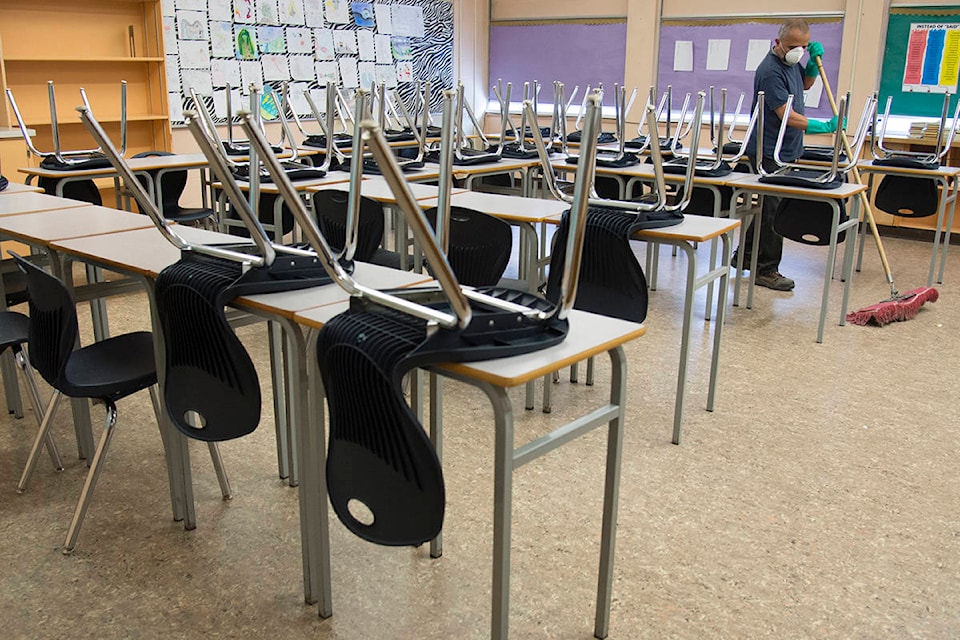The B.C. teacher’s union is calling for remote learning options, smaller class sizes and a stricter mask mandate as schools get ready to reopen next month.
On Wednesday (Aug. 19), the B.C. Teachers’ Federation rolled out a list of concerns about the province’s return-to-school plans. Currently, teachers are set to return on Sept. 8, with students coming two days later. In a statement, Education Minister Rob Fleming said the week of Sept. 8-11 will serve as a welcome week as students, teachers and other staff “adjust to their new routines, find out about their learning groups, and practice safety protocols.”
In a press release, BCTF president Teri Mooring said a recent spike in COVID-19 cases has lead to concerns for teachers, parents and students.
“In an ideal situation, back to learning would mean all schools are safe for 100 per cent of students, teachers, and support staff to return all at once,” Mooring said. “However, the sharp rise in active COVID-19 cases has many people worried that the government has not done enough to ensure teachers, students, and their families are safe.”
The BCTF’s concerns come as British Columbia has seen an increase in novel coronavirus cases in recent weeks. On Tuesday, the province recorded 83 cases, while the weekend saw 236 cases over three days. Friday’s 100 new cases was the second-highest figure recorded throughout the pandemic, and 775 are currently recovering from the virus. The union expressed more confidence in the province’s back-to-school plan prior to details being released.
READ MORE: BCTF president Mooring confident in province’s school plans
The education ministry’s return-to-school plan, created with the help of a steering committee that includes teachers and parents, places students in “learning groups” of 60 to 120, with elementary students getting the smaller end and high school students in the upper range, although many of the details are up to individual school districts. Surrey’s school district has said its cohorts will be “much smaller” than those laid out by the province. All school districts must present their safety and education plans to the province for approval, and release them publicly by Aug. 26.
READ MORE: B.C. to roll out ‘learning groups’ as part of COVID-19 back-to-school plan
“For students on our graduation program, again these are grades 10, 11 and 12, our cohort size is 30,” said superintendent Jordan Tinney. “For junior students, those in grades eight and nine, our cohort size is 60. We accomplish this by moving to a system that’s based on longer periods of instruction in 10-week increments.”
READ MORE: Surrey high school cohorts to be ‘much smaller,’ Tinney says
Staff and middle and high school students will be required to wear masks in high traffic areas, including hallways and on school buses, but not in classrooms. Elementary school students do not have to wear masks.
The teachers’ union is asking for the mask mandate to be expanded down to students aged 10 and older when physical distancing is not possible, regardless of what school they attend. Mooring also called for masks in classrooms, labs and libraries, as well as the areas the education ministry has laid out.
READ MORE: B.C. school staff, older students required to wear masks in ‘high traffic areas’
Mooring said a remote learning options should be available for the safety of immunocompromised staff and students, as well as to decrease the number of people in classrooms. In response, Fleming said the education ministery is working on “creative solutions creative solutions to support student choice while keeping students connected to their community school.”
Mooring also called out the lack of physical distancing in classrooms that host up to 30 students, along with teachers and support staff. In a statement, the education ministry said average class sizes are at 18 students for kindergarten (capped at 20), 19.5 for Grades 1 to 3 (cap 22), 23.3 students for Grades 4 to 7, 22.4 students for Grades 8 to 12. Both older groups do not have caps on class sizes.
“Physical distancing is not possible in these classrooms,” Mooring said. The situation will be particularly worrisome in B.C.’s largest and fastest growing districts that have hundreds of portables.”
In addition, the BCTF is calling for physical barriers to be installed where distancing is not possible and dedicated funding to improve ventilation and HVAC systems in schools.
Fleming noted the province is giving school districts $45.6 million enhanced cleaning, hand-washing stations, re-usable masks and other supplies. Schools will also receive 1.5 million masks, enough for each staff and student to have two each.
The BCTF’s representative assembly – made up of 300 teachers from local teachers’ unions – is scheduled to meet virtually on Aug. 28 to discuss any further response from the union.
– With files from Tom Zytaruk/Surrey Now Leader
Like us on Facebook and follow us on Twitter.
Want to support local journalism during the pandemic? Make a donation here.
